"Angara-A5" on Vostochny: the foundation for a great future
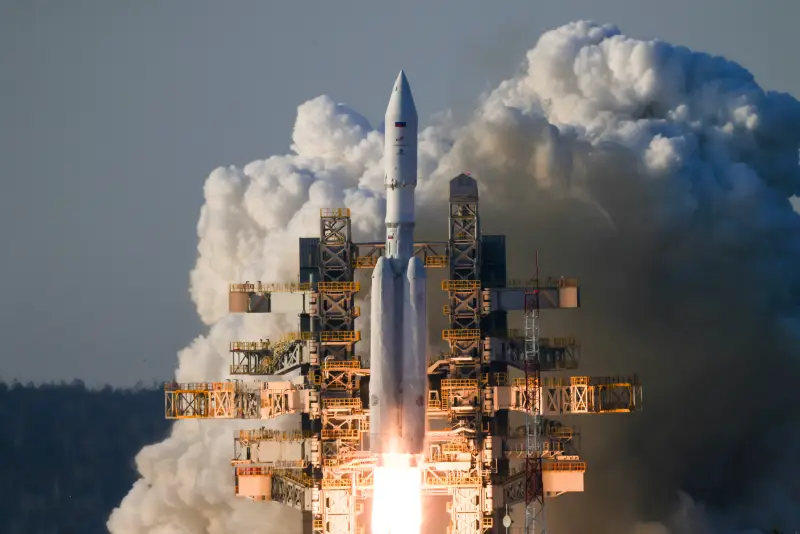
Launch of "Anragy-A5" from Vostochny, April 11, 2024
On April 11, the first launch of the promising Angara-A5 heavy-class launch vehicle took place from the Vostochny Cosmodrome. The launch was successful, and the rocket's payload was delivered to the desired orbit at the estimated time. This event is of particular importance for Russian cosmonautics. It shows the readiness of the rocket and the new launch pad for full operation, and also determines the path for the development of the industry for the long term.
First start
As the Roscosmos state corporation reported, the Angara-A5 rocket for the first launch from Vostochny was built at the end of last year. In the last ten days of December, PA "Polet" (Omsk) from the State Space Research and Production Center named after. M.V. Khrunichev sent the product in disassembled form to the cosmodrome. In January, Vostochny received the rocket and began preparations for a future launch. At the same time, the Energia rocket and space corporation sent the 14C48 Orion upper stage to the cosmodrome.
Assembling the rocket and installing the payload, testing and other activities took several months. On March 26, the Angara-A5 was taken out of the workshop and installed at the launch complex, after which a new stage of preparation for the flight began. Over the next two weeks, systems and units were checked, refueling, etc.
The rocket's launch was initially scheduled for noon on April 9. The final preparations went according to plan, but two minutes before launch the automation reported problems and canceled further procedures. Soon, Roscosmos said that there was a failure in the pressurization system of the oxidizer tank in the central block module of the rocket. Specialists began to fix this problem, and the launch was postponed for a day.
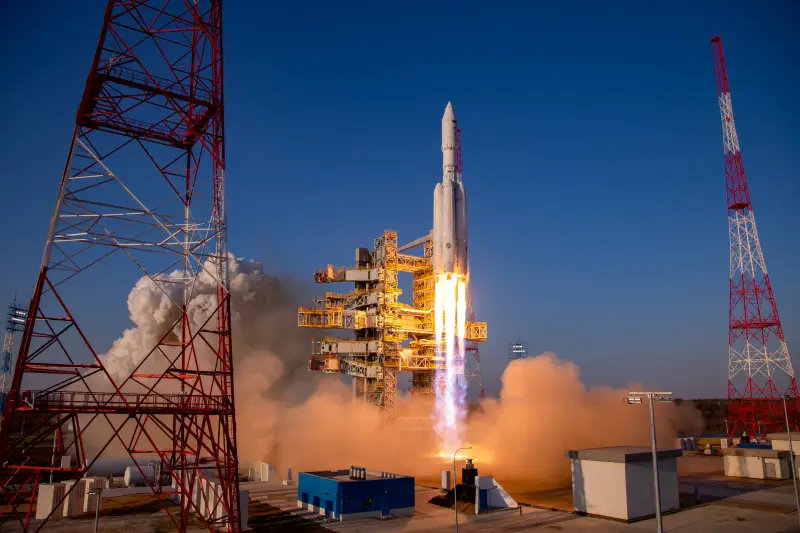
On April 10, the second launch attempt also failed. Immediately before the start, the automation noticed problems in the launch control system of one of the engines. To avoid undesirable consequences, the launch was interrupted. The Angara-A5 flight was again postponed for a day due to the need to correct the identified deficiency.
Finally, on April 11 at 12:00 Moscow time, the launch vehicle, having gone through all the procedures and automatic checks, turned on the engines and took off from the launch pad. Over the next few minutes, Angara-A5 gained the required altitude and speed, followed the specified trajectory and launched the payload into the intended orbit. The launch and flight took place without any problems and were considered successful.
The Orion upper stage with a spacecraft weight simulator, as well as the Gagarinets small satellite, were used as a test payload on the rocket. The latter separated from the rocket in low orbit, and Orion continued its flight. At 19:50, Roscosmos reported that the upper stage with the test load had successfully reached the design point of the geostationary orbit; the load was not separated. In the near future, in order not to interfere with space activities, Orion with a test cargo will move to a storage orbit.
Confirmed by practice
The launch on April 11 was carried out as part of flight development tests of the Amur missile complex, consisting of the Angara-A5 rocket and the Orion upper stage. Despite all the delays and two postponements, it took place and was considered successful. At the same time, during preparation for the launch and during the flight, a number of important tasks took place, and their successful solution contributes to the further development of the Angara and Amur programs, and also has a positive impact on the prospects of the rocket and space industry.
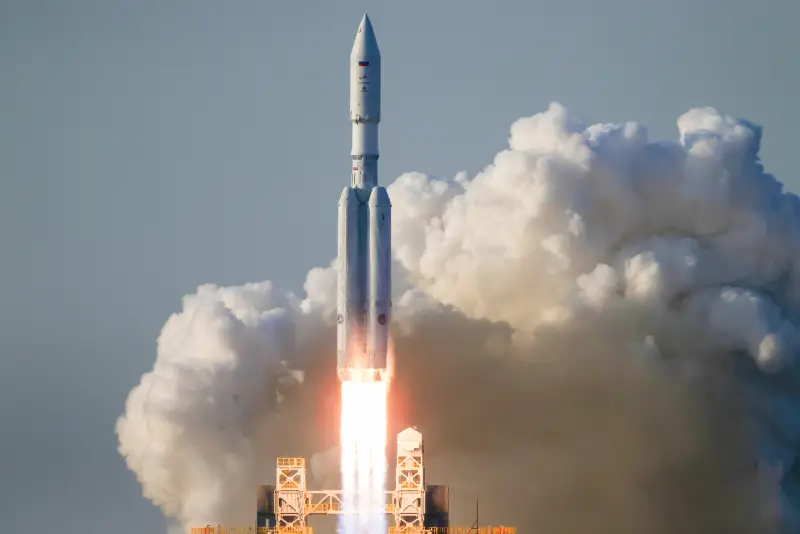
The Angara-A5 product for the recent flight was manufactured by the Omsk Polyot Production Association. This enterprise mastered the production of Angara family missiles only in the second half of the XNUMXs, and to date has managed to build only three heavy-class carriers. During the construction of the next rocket, Polet specialists were able to check the production line and supplement existing experience. Similar results from current work will help the serial construction of rockets in the future.
The entire new infrastructure of the Vostochny Cosmodrome has been tested. The installation and testing complex and its personnel confirmed their competence in the field of launch vehicle assembly and payload installation. The newly built launch complex and associated support facilities were inspected. If there were any difficulties, we dealt with them and gained the necessary experience useful for further work.
Unfortunately, the launch of Angara-A5 had to be postponed twice due to the incorrect operation of individual systems. However, correcting the shortcomings did not take much time. In addition, these incidents helped identify new potential sources of problems. Based on the results of the work carried out, the design of the rocket and its components will be improved to eliminate such situations in the future. Such results of work fully justify the postponement of the launch.
After correcting all the shortcomings, Angara-A5 successfully launched the Orion upper stage into a given orbit and confirmed its characteristics when launched from the new cosmodrome. Then the upper stage demonstrated its potential, delivering its cargo into geostationary orbit in a few hours. At the same time, data on the operation of all systems has been collected, on the basis of which conclusions can be drawn about the need for further improvement of the Angara or Orion.
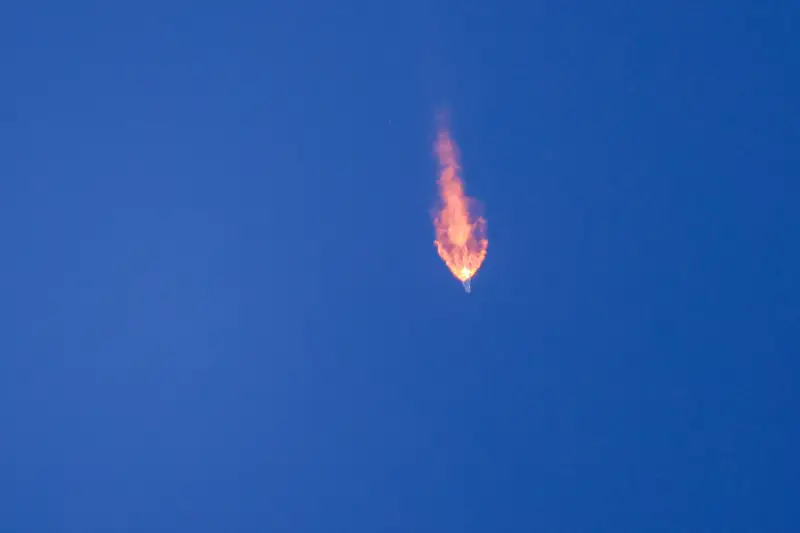
Global implications
The rocket and space complex based on the Angara-A5 heavy-duty launch vehicle continues to undergo flight design tests, demonstrates its potential, and also helps to identify and correct design flaws. All these activities bring the launch of full operation of the new rocket and the new launch complex closer. In addition, current work will have a serious impact on the further development of domestic astronautics.
The main result of the Angara-A5 project is the emergence of a new heavy-class launch vehicle. For now, this niche is occupied by the Proton product, but its operation will be completed in the near future. The two rockets have similar payload characteristics, and the appearance of the heavy Angara will allow our rocket and space industry to maintain the required capabilities for launching heavy loads.
Angara-A5 has a number of important advantages over Proton. First of all, this is the novelty of the design. Officially, the Angara project started in 1995, but active work began later. The first launch of the new family of rockets took place in 2014. The new launch vehicle was built using modern technologies and materials, as well as taking into account the operating experience of older equipment. In addition, it was created from scratch and without the restrictions typical for projects to modernize existing products.
With the required characteristics, the Angara-A5 is easier and cheaper than the Proton to operate. Thus, all stages of the new rocket use kerosene as fuel, and liquid oxygen serves as the oxidizer. Proton engines use unsymmetrical dimethylhydrazine and nitrogen tetroxide, which are dangerous and require special measures. Refusal of such a fuel pair makes it possible to simplify the ground infrastructure of the missile system and reduce the cost of operation. Fuel standardization with other modern carriers is also ensured.
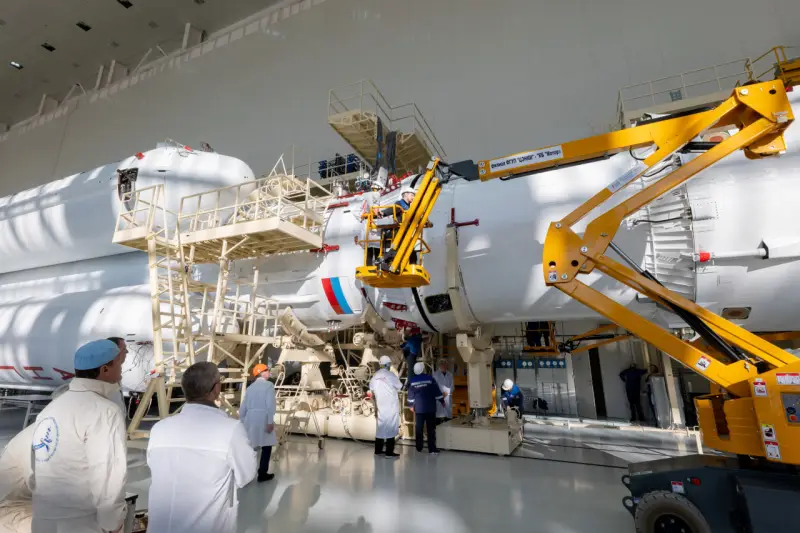
Rocket under assembly, March 2024
After completion of flight development tests, Angara-A5 will be involved in real projects. With its help, it is planned to send blocks of the future ROS orbital station into orbit. It is also expected to be used in manned missions, incl. in the most difficult ones. Unlike Proton, the new rocket will be able to lift heavy spacecraft with a crew on board.
Previously, Angara rockets were launched from the Plesetsk cosmodrome, which has its own characteristics and limitations. Operation of the launch complex on Vostochny has now begun. This facility has a more advantageous geographical location and allows for better results in the context of launches. In addition, Vostochny is located on Russian territory, and its operation does not depend on third countries. All this provides new important opportunities.
It should be recalled that the key feature of the Angara project is the modular architecture of the missiles. Media with different characteristics are assembled from standardized modules in one quantity or another. Due to this, it is possible to build rockets of different configurations with different payload capacities, and in the future such products will be able to replace not only the Proton, but also other carriers.
Reserve for the future
Thus, the domestic industry has successfully developed and brought to testing a new heavy-class launch vehicle and is already testing it at a new site. All necessary tests and related activities may take several more years, after which the Angara-A5 will go into full operation. In the future, other products of the promising family will be put into operation.
It is assumed that the new Angara-A5 rocket will occupy the niche of a heavy carrier over the next few decades. This means that the implementation of both already planned programs of various kinds and future promising projects directly depends on it. Accordingly, the recent launch of a new rocket from the Vostochny Cosmodrome is the most important event in stories national cosmonautics, and its importance is already difficult to overestimate.
Information